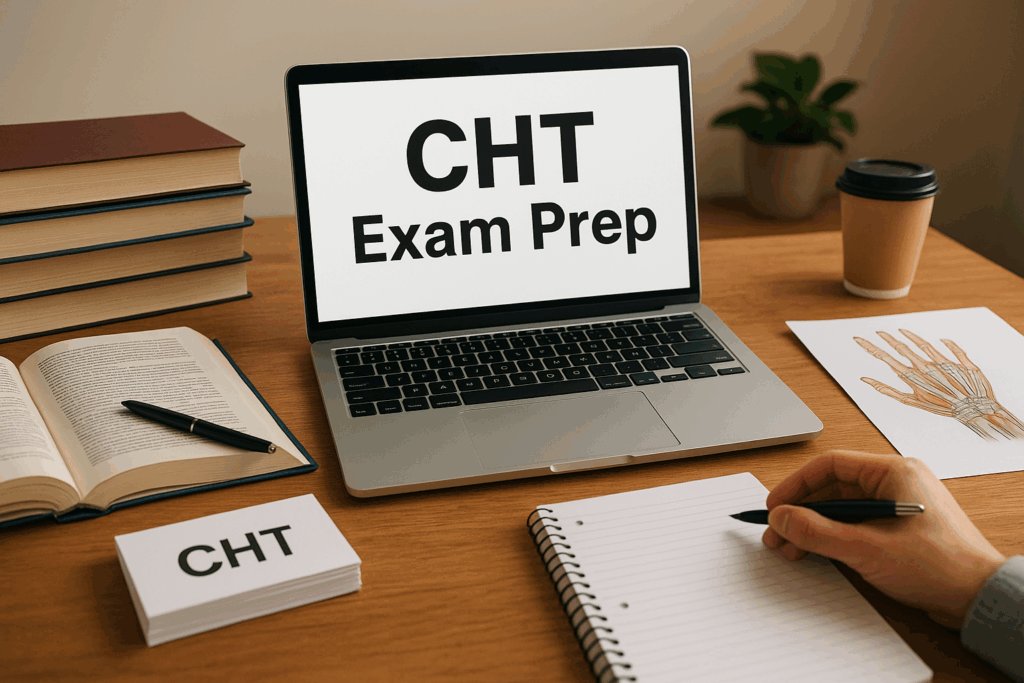Ultimate Guide to CHT Exam Prep: Proven Strategies for Certified Hand Therapist Success
Filed under Uncategorized
Introduction to the CHT Exam
What is the CHT Certification?
The Certified Hand Therapist (CHT) credential is a prestigious and advanced professional certification for occupational and physical therapists. It demonstrates specialized knowledge in upper limb rehabilitation, including the hand, wrist, elbow, and shoulder. This certification is jointly administered by the Hand Therapy Certification Commission (HTCC) and is recognized globally in clinical hand therapy circles.
Who is Eligible to Take the CHT Exam?
To qualify for the CHT exam, a candidate must:
- Be a licensed occupational or physical therapist.
- Have at least 3 years of clinical experience.
- Complete a minimum of 4,000 hours of direct hand therapy practice.
These strict prerequisites ensure that only dedicated, experienced professionals attempt this challenging exam.
Why Become a Certified Hand Therapist?
Becoming a CHT has numerous benefits:
- Professional recognition and credibility
- Higher salary potential
- Expanded job opportunities
- Enhanced clinical decision-making
- Increased patient trust and referral opportunities
This certification can be a turning point in your rehabilitation career.

Understanding the Exam Structure
Format and Duration
The CHT exam consists of 200 multiple-choice questions. You’ll have 4 hours to complete the test. The exam is administered at Prometric testing centers or remotely, depending on your location and availability.
Question Types and Domains Covered
The exam covers four main content domains:
- Domains of Hand Therapy
- Diagnoses and Conditions
- Medical and Surgical Procedures.
- Treatment Techniques and tools
Expect case-based scenarios, diagram-based questions, and clinical decision-making challenges that test real-world application of knowledge.
Scoring System Explained
Scores are scaled between 200 and 800. Exact pass scores vary slightly by year and form of the test. You’ll receive your results within 6–8 weeks after the exam.
Setting a Strong Foundation
How to Set SMART Goals for Studying
SMART goals (Specific, Measurable, Achievable, Relevant, Time-bound) are key to structured studying. For example:
- “I will complete two chapters of my review manual each week.”
- “I’ll finish 100 practice questions every weekend.”
Creating a Personalized Study Plan
Break your study schedule into weekly and monthly goals based on the time you have until the exam. Include:
- Core study material coverage
- Practice test days
- Rest and review weeks
Recommended Study Timeline
| Study Timeline | Ideal For |
| 12 Months | Working full-time with family or other obligations |
| 6 Months | Moderate availability, balanced workload |
| 3 Months | Intense, focused full-time prep |
Best Study Resources for CHT Exam Prep
Top Books and Manuals
- Rehabilitation of the Hand and Upper Extremity by Skirven
- Orthotic Intervention for the Hand and Upper Extremity by Jacobs & Austin
- Fundamentals of Hand Therapy by Coppard & Lohman
Online Courses and Webinars
- AOTA-approved prep courses, such as CHT Prep by Hand Therapy Academy
- Rehab professionals’ YouTube channels
- ASHT webinars and continuing ed resources
Active Learning Techniques
Case-Based Learning
Apply theory to practice by reviewing clinical case studies. Think critically: What’s the diagnosis? What interventions would you choose?
Teaching Concepts to Others
Teaching forces you to deeply understand concepts. Host mini “teach-back” sessions with peers or coworkers.
Practice Questions and Mock Exams
Take full-length practice tests under timed conditions. Use results to adjust your focus.
Managing Time and Avoiding Burnout
Weekly Study Scheduling Tips
- Block 30–60 minutes daily.
- Reserve time on the weekends for deep dives.
- Include breaks and “catch-up” days.
Avoiding Overwhelm
Recognize signs of burnout early—fatigue, frustration, declining retention. Adjust pace and integrate stress management strategies.
Rest, Nutrition, and Exercise Balance
- Get 7–8 hours of sleep.
- Eat balanced meals with brain-boosting nutrients.
- Include movement or light workouts in your routine.
Memorization Strategies for Key Concepts
Mnemonics and Acronyms
Examples:
- “Some Lovers Try Positions That They Can’t Handle” – for carpal bone order.
- “DEFORM” – stages of wound healing.
Chunking and Spaced Repetition
Break topics into digestible sections and revisit them frequently. Use flashcard toolsi for spaced repetition.
Visual Diagrams and Mind Maps
Sketch nerve paths, tendon zones, and orthotic designs. Visual learners especially benefit from this technique.
Joining a Study Group or Forum
Benefits of Peer Learning
- Accountability
- Idea sharing
- Emotional support
Top Online CHT Study Communities
- Reddit’s r/occupationaltherapy
- Facebook groups like “CHT Exam Study Group”
- OT/PT Discord communities
Finding a Study Buddy
Partner with someone who’s preparing for the exam too. You can quiz each other and share insights.
Practice Test Strategy
How to Analyze Your Mistakes
After every practice test:
- Categorize mistakes by topic.
- Review and re-learn that concept.
- Retest after a few weeks.
- Use the post test categories from CHT Prep from Hand Therapy Academy’s exams
Time Management During Exams
- Spend no more than 1.5 minutes per question.
- Flag hard ones and revisit with remaining time.
Simulating Real Exam Conditions
Sit at a desk with no distractions. Use a timer. Take breaks only at designated times, mimicking actual exam behavior. Use the CHT Practice Test simulator that contains 200 questions from real tests (three versions of the test are available) and provides detailed feedback with rationale and references for all of the answers.
Day Before the CHT Exam
What to Bring
Pack your bag early and make sure it includes:
- Government-issued photo ID
- Prometric confirmation email or test admission letter
- Disposable bottle of water (if allowed)
Confirm the testing location and how long it will take you to get there.
How to Calm Pre-Exam Anxiety
- Meditate for 5–10 minutes using apps like Headspace or Calm.
- Limit caffeine intake and aim for restful sleep.
- Avoid cramming; light review is better for retention.
Final Review Strategy
Focus on:
- Flashcards and quick notes
- High-yield summaries
- Topics you consistently miss on practice tests
Don’t introduce new material at the last minute—it can increase stress without improving performance.
Test Day Tips for Success
Arriving Early and Checking In
Plan to arrive at least 30–45 minutes early. Testing centers have strict protocols:
- No phones or smartwatches allowed
- Lockers are usually provided
- You may undergo a security screening
Managing Exam Stress in Real-Time
If you start to feel anxious during the test:
- Take 3 deep breaths
- Stretch your arms and neck discreetly
- Close your eyes for 30-60 seconds to avoid screen fatigue
Staying Focused and Alert
- Use the on-screen timer to pace yourself
- Take allowed breaks wisely
- Don’t dwell on difficult questions—mark and move on
What to Do After the Exam
Understanding Preliminary Scores
At some centers, you may receive a preliminary pass/fail notification. The official score report will arrive via email or your HTCC account within several weeks.
Steps if You Pass
- Celebrate your accomplishment!
- Update your credentials
- Inform your employer and network
- Consider mentoring others preparing for the exam
What to Do If You Don’t Pass
- Wait for a breakdown of your score
- Reflect on areas for improvement
- Take a short break before restarting prep
- You can retake the exam in 6 months
Success Stories from Real CHTs
What Worked for Them
- “I started 6 months ahead and studied 5 days a week.”
- “Practicing the real test at the HTA website was a game-changer.”
- “Daily flashcards helped me master nerve innervations.”
Study Routines Shared
- Early morning reviews
- Weekly practice exams
- Sunday summaries of weekly learning
Lessons Learned
- “Don’t neglect orthotics, even if you think you know them.”
- “Invest in quality resources—it saves time.”
- “Make rest days part of your plan.”
Top Mistakes to Avoid During CHT Exam Prep
Procrastination
Delaying your study schedule increases anxiety and decreases retention. Start early and stay consistent.
Ignoring Weak Areas
Focusing only on favorite topics leaves gaps. Identify your weaknesses early through practice tests.
Not Taking Enough Practice Exams
Practice exams build endurance and help simulate test conditions. Try to complete at least 3 full-length mock tests.
FAQs About CHT Exam Prep
1. How hard is the CHT exam?
The CHT exam is challenging due to the breadth of content and clinical reasoning involved. But with consistent, focused preparation, many therapists succeed on their first try.
2. What is the pass rate?
The pass rate typically hovers around 60–70%, depending on the year. Preparation is crucial.
3. How much time should I spend studying?
Most candidates study between 150–300 hours over 3 to 12 months. Your timeline depends on experience and available study time.
4. Are there prep courses that guarantee results?
No course can guarantee a pass, but reputable ones like CHT Prep Course by Hand Therapy Academy offer valuable structure and support.
5. Can I work full-time and still pass the CHT exam?
Yes! Many successful candidates balanced full-time jobs with study by creating structured plans and using weekends or early mornings.
6. How often can I retake the exam?
You can retake the CHT exam every 6 months, up to three times within a 3-year period from initial eligibility.
Conclusion: You Can Pass the CHT Exam With Confidence
Preparing for the CHT exam is a journey—one that builds not just knowledge, but clinical confidence. By creating a smart plan, using the best resources, and prioritizing your mental and physical health, you can absolutely pass the CHT exam.
Remember, every Certified Hand Therapist started right where you are now—with questions, doubts, and determination.
Stay focused. Stay consistent. And most importantly—believe in your ability to succeed.
More To Read
“Do joint mobilizations assist in the recovery of lateral elbow tendinopathy? A systematic review and meta-analysis”
By Sophia Grimm Lucado, A. M., Dale, R. B., Vincent, J., & Day, J. M. (2019). Do joint mobilizations assist in the recovery of lateral elbow tendinopathy? A systematic review and meta-analysis. Journal of hand therapy : official journal of the American Society of Hand Therapists, 32(2), 262–276.e1. https://doi.org/10.1016/j.jht.2018.01.010 The Skinny: The purpose of this study was…
Read MoreHow to Improve HEP Adherence for Optimal Rehabilitation Outcomes
By Sophia Grimm A lack of adherence to home exercise programs in rehabilitation is a significant problem, with nonadherence estimates as high as 30-65% for general musculoskeletal conditions. This could have potentially detrimental effects on patients’ clinical rehabilitation outcomes as the success of certain medical interventions depends largely on patient adherence to advice and prescribed rehabilitation…
Read MoreThumbs up for treating thumb pain in the hand therapy clinic
What do “Mommy’s thumb,” “gamer’s thumb,” and “radial styloid tenosynovitis” have in common? They are all officially called de Quervain’s tenosynovitis De Quervain’s involves the tendons within the first dorsal compartment, abductor pollicis longus (APL) and extensor pollicis brevis (EPB) and arises when the tendons are inflamed and are not able to move through the…
Read MoreCarpal Tunnel Syndrome: How does traditional hand therapy compare with neurodynamic therapy?
Hamzeh, H., Mohammad, M., Alghwiri, A., & Hawamdeh, Z. (2021). The long-term effect of neurodynamics vs. exercise therapy on pain and function in people with carpal tunnel syndrome: A randomized parallel-group clinical trial. Journal of Hand Therapy, 34, 521-530. The Skinny: Carpal tunnel is the most common peripheral nerve compression problem. There is now some…
Read MoreSign-up to Get Updates Straight to Your Inbox!
Sign up with us and we will send you regular blog posts on everything hand therapy, notices every time we upload new videos and tutorials, along with handout, protocols, and other useful information.






